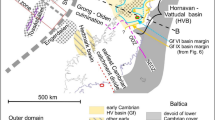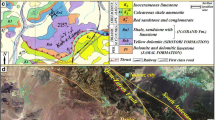Abstract
The Sylhet Trough, a petroleum province of the Bengal Basin, accommodates a huge thickness of Eocene to Recent sedimentary successions. However, the basin-fill history of the trough is poorly understood; specifically, constrains on timing of deposition of the individual units are yet to be established. Therefore, we aimed at establishing sedimentation and basin-fill history of the Sylhet Trough based on detailed lithofacies analysis of the outcropping Cenozoic succession. We have divided the entire Cenozoic succession into three megasequences which can be further sub-divided into nine lithostratigraphic units based on bounding discontinuities, such as transgressive erosion surface, regressive erosion surface, transgressive surface, marine flooding surface, and incised valley floor. The oldest is the Megasequence 1, comprised of shallow marine shelfal deposits overlain by shallow marine to nearshore deposits. In the middle, the Megasequence 2 is representing tide-dominated marine to coastal (deltaic) depositional systems with evidence of cyclic marine regression and transgression. Repetitive occurrence of incised channel, tidal inlet, tidal ridge/shoal, tidal flat and other tidal deposits are separated by shelfal deposits. The top of the Megasequence 2 is marked by a pronounced erosion surface interpreted as an incised valley floor indicating the final phase of marine regression followed by the gradual establishment of the overlying continental-fluvial depositional systems (i.e., the Megasequence 3). This youngest megasequence is characterized by stacked braided river sand bars that pass up-sequence into meandering river deposits. Based on the Cenozoic eustatic sea level curve, we suggest that the upper boundaries of the Megasequence 1 and Megasequence 2 are approximately at 39.5 Ma and 5.0 Ma, respectively.













Similar content being viewed by others
References
Abdullah R, Yeasmin R, Ameen SM, Khanam F, Bari Z (2015) 2D structural modelling and hydrocarbon potentiality of the Sitakund structure, Chittagong Tripura Fold Belt, Bengal Basin, Bangladesh. J GeolSoc India 85(6):697–705
Alam M (1989) Geology and depositional history of Cenozoic sediments of the Bengal Basin of Bangladesh. Palaeogeography Palaeoclimatology Palaeoecology 69:125–139
Alam M (1995a) Sedimentology and depositional environments of the Bengal Basin subsurface Neogene succession based on detailed facies and electrofacies analysis: a case study of the Kailashtila, Rashidpur and Bakhrabad structures in northeastern Bangladesh. NORAD Project BGD-023, Bangladesh Petroleum Institute, Dhaka
Alam M (1995b) Tide-dominated sedimentation in the upper Tertiary succession of the Sitapahar anticline, Bangladesh. In: Flemming BW, Bortholma A (eds) Tidal signatures in modern and ancient sediments, vol 24. International Association for Sedimentologist Special Publication, pp 329–341
Alam MK, Hasan AKM, Khan MR, Whitney JW (1990) Geological map of Bangladesh. Ministry of Energy and Mineral Resources, Geological Survey of Bangladesh with cooperation of U.S. Geol Survey 1:1000000
Alam M, Alam MM, Curray JR, Chowdhury MLR, Gani MR (2003) An overview of the sedimentary geology of the Bengal Basin in relation to the regional tectonic framework and basin-fill history. SedGeol 155:179–208
Allen R, Najman Y, Carter A, Barfod D, Bickle MJ, Chapman HJ, Garzanti E, Vezzoli G, Ando S, Parrish RR (2008) Provenance of the Tertiary sedimentary rocks of the Indo-Burman Ranges, Burma (Myanmar): Burman arc or Himalayan-derived? J GeolSoc 165(6):1045–1057
Bilham R, England P (2001) Plateau ‘pop-up’in the great 1897 Assam earthquake. Nature 410(6830):806–809
Biswas S, Grasemann B (2005) Quantitative morphotectonics of the southern Shillong plateau (Bangladesh/India). Aust J Earth Sci 97:82–93
Brouwers EM, Khan M, Akhtar A (1992) Microfossil Assemblages from the Eocene Sylhet Limestone and Kopili Formation, Sylhet District, Northeast Bangladesh. US Geol Survey 45
Chowdhury K, Biswas S, Ahmed A (1996) The structural and tectonic set-up of Jaintiapur and adjacent areas, Sylhet District, Bangladesh. BangladeshGeosci J 2:1–14
Collinson J, Reading H (1996) Sedimentary environments: processes, facies and stratigraphy. Alluvial Sediments. Blackwell Scientific Publications, Oxford, pp 37–82
Curiale JA, Covington GH, Shamsuddin AHM, Morelos JA, Shamsuddin AKM (2002) Origin of petroleum in Bangladesh. AAPG Bull 86(4):625–652
Dalrymple R (2010) Facies models 4. Tidal depositional systems. Geological Society of Canada, pp 201–231
DeCelles PG, Kapp P, Gehrels GE, Ding L (2014) Paleocene-Eocene foreland basin evolution in the Himalaya of southern Tibet and Nepal: Implications for the age of initial India-Asia collision. Tectonics 33(5):824–849
Evans P (1932) Tertiary succession in Assam. Trans Min GeolInst India 27:155–260
Gani MR, Alam MM (2003) Sedimentation and basin-fill history of the Neogene clastic succession exposed in the southeastern fold belt of the Bengal Basin, Bangladesh: a high-resolution sequence stratigraphic approach. SedGeol 155:227–270
Haq BU, Hardenbol J, Vail PR (1987) Chronology of fluctuating sea levels since the Triassic. Science 235:1156–1167
Hiller K, Elahi M (1984) Structural development and hydrocarbon entrapment in the Surma basin/Bangladesh (northwest Indo Burman fold belt): Fifth Offshore Southwest Conference, Singapore 656–663
Holtrop J, Keizer J (1970) Some aspects of the stratigraphy and correlation of the Surma Basin wells, East Pakistan. ECAFE Miner Resour Dev Ser 36:143–154
Hossain MS, Khan MSH, Chowdhury KR, Abdullah R (2019) Synthesis of the tectonic and structural elements of the Bengal Basin and its surroundings. In: Mukherjee S (ed) Tectonics and structural geology: Indian context. Springer International Publishing AG, Cham, pp 135–218
Hu X, Garzanti E, Moore T, Raffi I (2015) Direct stratigraphic dating of India-Asia collision onset at the Selandian (middle Paleocene, 59 ± 1 Ma). Geology 43(10):859–862
Johnson SY, Alam AMN (1991) Sedimentation and tectonics of the Sylhet trough, Bangladesh. GeolSoc Am Bull 103:1513–1527
Khan M, Biswas S, Singh S, Pati P (2006) OSL choronology of Dihing formation and recent upliftment rate along the Dauki Fault, NE Bangladesh. BangladeshGeosci J 12:1–11
Khanam F, Rahman MJJ, Alam MM, Abdullah R (2017) Facies characterization of the Surma Group (Miocene) sediments from Jalalabad gas field, Sylhet Trough, Bangladesh: study from cores and wireline log. J GeolSoc India 89(2):155–164
Licht A, Dupont-Nivet G, Win Z, Swe HH, Kaythi M, Roperch P, Ugrai T, Littell V, Park D, Westerweel J, Jones D (2019) Paleogene evolution of the Burmese forearc basin and implications for the history of India–Asia convergence. GSA Bull 131(5–6):730–748
Maltman A (2012) The geological deformation of sediments. Springer, New York
Maurin T, Rangin C (2009) Structure and kinematics of the Indo–Burmese Wedge: recent and fast growth of the outer wedge. Tectonics 28 TC2010
Miall AD (2010) The geology of stratigraphic sequences. Springer, New York
Najman Y, Bickle M, BouDagher-Fadel M, Carter A, Garzanti E, Paul M, Wijbrans J, Willett E, Oliver G, Parrish R (2008) The Paleogene record of Himalayan erosion: Bengal Basin, Bangladesh. Earth Planet SciLett 273:1–14
Najman Y, Allen R, Willett EA, Carter A, Barfod D, Garzanti E, Wijbrans J, Bickle MJ, Vezzoli G, Ando S, Oliver G (2012) The record of Himalayan erosion preserved in the sedimentary rocks of the Hatia Trough of the Bengal Basin and the Chittagong Hill Tracts, Bangladesh. Basin Res 24(5):499–519
Najman Y, Bracciali L, Parrish RR, Chisty E, Copley A (2016) Evolving strain partitioning in the Eastern Himalaya: the growth of the Shillong Plateau. Earth Planet SciLett 433:1–9
Powell CM (1979) A speculative tectonic history of Pakistan and surroundings. Geodyn Pak
Rahman MJJ, Faupl P, Alam MM (2009) Depositional facies of the subsurface Neogene Surma Group in the Sylhet Trough of the Bengal Basin, Bangladesh: record of tidal sedimentation. Int J Earth Sci 98(8):1971
Rahman MJJ, Xiao W, Hossain MS, Yeasmin R, Sayem ASM, Ao S, Yang L, Abdullah R, Dina NT (2020) Geochemistry and detrital zircon U–Pb dating of Pliocene–Pleistocene sandstones of the Chittagong Tripura Fold Belt (Bangladesh): Implications for provenance. Gondwana Res 78:278–290
Reimann KU (1993) Geology of Bangladesh. G. Borntraeger, Berlin
Replumaz A, Tapponnier P (2003) Reconstruction of the deformed collision zone between India and Asia by backward motion of lithospheric blocks. J Geophys Res Solid Earth 108(B6)
Roy MK, Roy PJ, Akter MS, Chowdhury BK (2009) Facies and depositional environment of the Sylhet Limestone Formation and Kopili Formation as exposed in the Surma Basin, Northeastern Bangladesh. IUP J Earth Sci 30901:16
Roy PJ, Roy MK, Akter MS (2008) Sequence stratigraphy and paleogeographic settings of the Sylhet Limestone and Kopili formations exposed in parts of Bengal Basin, Bangladesh . Indian AssocSedimentol 27:55–63
Shamsuddin A, Abdullah S (1997) Geologic evolution of the Bengal Basin and its implication in hydrocarbon exploration in Bangladesh. Indian J Geol 69:93–121
Tapponnier P, Peltzer G, Armijo R (1986) On the mechanics of the collision between India and Asia. GeolSocLond Spec Publ 19:113–157
Uddin A, Lundberg N (1998) Cenozoic history of the Himalayan-Bengal system: Sand composition in the Bengal basin, Bangladesh. GSA Bull 110(4):497–511
Worm HU, Ahmed AMM, Ahmed NU, Islam HO, Huq MM, Hambach U, Lietz J (1998) Large sedimentation rate in the Bengal delta: magnetostratigraphic dating of Cenozoic sediments from northeastern Bangladesh. Geology 26(6):487–490
Wu FY, Ji WQ, Wang JG, Liu CZ, Chung SL, Clift PD (2014) Zircon U–Pb and Hf isotopic constraints on the onset time of India–Asia collision. Am J Sci 314(2):548–579
Yang L, Xiao W, Rahman MJJ, Windley BF, Schulmann K, Ao S, Chen Z, Li R (2019) Provenance of the Cenozoic Bengal Basin sediments: Insights from U–Pb ages and Hf isotopes of detrital zircons. Geol J 54(2):978–990
Yang L, Xiao W, Rahman MJJ, Windley BF, Schulmann K, Ao S, Zhang JE, Chen Z, Hossain MS, Dong Y (2020) Indo–Burma passive amalgamation along the Kaladan Fault: Insights from zircon provenance in the Chittagong-Tripura Fold Belt (Bangladesh). GSA Bull 132(9–10):1953–1968
Yin A, Dubey CS, Webb AAG, Kelty TK, Grove M, Gehrels GE, Burgess WP (2010) Geologic correlation of the Himalayan orogen and Indian craton: Part 1. Structural geology, U–Pb zircon geochronology, and tectonic evolution of the Shillong Plateau and its neighboring regions in NE India. Geol Soc Am Bull 122(3-4):336–359
Acknowledgements
This research work is a part of the Doctoral thesis of the first author (Farida Khanam). We are grateful to ‘Banggabandu Fellowship Program’, Ministry of Science and Technology Bangladesh, for financial support. We thank Dr. Asghar A.A.D. Hakro and an anonymous reviewer for their constructive comments and suggestions to improve the manuscript. We also thank Professor Wolf-Christian Dullo, Editor in Chief and Professor Wenjiao Xiao, Editor, International Journal of Earth Sciences for their support in the review processes. Especial thanks to Professor Joan Esterle, School of Earth and Environmental Sciences, University of Queensland, Australia, for her valuable suggestions in improving the discussion section.
Author information
Authors and Affiliations
Corresponding author
Rights and permissions
About this article
Cite this article
Khanam, F., Rahman, M.J.J., Alam, M.M. et al. Sedimentology and basin-fill history of the Cenozoic succession of the Sylhet Trough, Bengal Basin, Bangladesh. Int J Earth Sci (Geol Rundsch) 110, 193–212 (2021). https://doi.org/10.1007/s00531-020-01946-1
Received:
Accepted:
Published:
Issue Date:
DOI: https://doi.org/10.1007/s00531-020-01946-1




